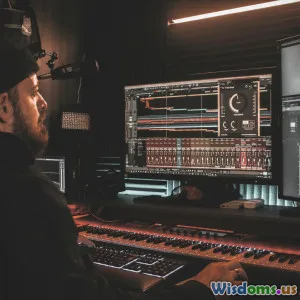
Journey of a Backup Singer to Solo Stage Stardom
9 min read Explore the transformation from backup singer to solo stardom with inspiring stories, strategies, and industry insights for aspiring artists. (0 Reviews)
Journey of a Backup Singer to Solo Stage Stardom
Transitioning from the shadows of the spotlight to center stage is a dream shared by many backup singers. These talented performers, often overshadowed by lead artists, possess the vocal prowess, stage charisma, and resilience needed to succeed on their own. Yet, the journey from backup vocalist to solo star is a complex and demanding process that requires more than just talent.
This article unpacks the roadmap of this exciting transformation, drawing on real-world examples, expert insights, and actionable strategies. If you're an aspiring backup singer yearning for solo recognition or a music enthusiast curious about the intricacies of artist development, read on for a compelling exploration of this musical evolution.
The Role and Reality of a Backup Singer
Understanding the Backup Singer’s Craft
Backup singers support the main vocalists by harmonizing, enriching the sonic texture, and elevating the emotional impact of a song. Their role is essential in creating a full and dynamic live performance or recording experience. However, unlike lead singers who command attention, backup singers are often anonymous to the broader audience.
For example, longtime backup vocalist Lisa Fischer, who toured and recorded with icons such as The Rolling Stones and Tina Turner, showcases the indispensability of backup singers in music history. Her dynamic vocal range and soulful harmonies added depth to concerts and albums renowned worldwide.
Challenges Faced by Backup Singers
Despite their contributions, backup singers are frequently underappreciated publicly. Limited exposure, fewer solo opportunities, and sometimes unequal pay can present obstacles. Furthermore, transitioning to a solo career requires carving out a unique artistic identity distinct from the lead artist they once supported.
This reality underscores the importance of strategic self-development and network expansion for backup singers aspiring to break out independently.
Step 1: Building a Distinctive Artistic Identity
Discovering Your Voice Beyond Harmony
An essential step is moving beyond the purely supportive role to establish a unique sound and style. This involves vocal experimentation, songwriting, and embracing genres that resonate personally.
As noted by Grammy-winning artist and former backup singer Meghan Trainor, "Finding your true voice is about tapping into your genuine feelings and experiences — that's what makes your music compelling."
Crafting a Personal Brand
A strong personal brand helps create an emotional connection with audiences and industry professionals. This includes not just musical style, but image, social media presence, and storytelling.
Take, for instance, Becky G, who gained initial exposure as a backup singer and dancer before launching a solo career characterized by a distinctive fusion of pop and Latin influences, supported by active social media engagement and clear branding.
Step 2: Gaining Visibility and Experience
Leveraging Backup Opportunities for Exposure
Working with well-known artists can provide invaluable exposure and credibility. Backup singers should treat these roles as auditions for their eventual solo careers by showcasing exceptional professionalism and occasional moments of individuality during performances.
Sia Furler exemplifies this pathway. Before rising to fame as a solo artist, she lent her voice and songwriting skills as a backup singer, gaining firsthand industry insights.
Expanding Stage Presence and Networking
Participation in diverse live shows, studio sessions, and collaborations widens industry connections. Networking with producers, songwriters, and musicians opens doors to solo projects.
Backing up Beyoncé on tour, for example, famously brought Kelly Rowland invaluable networking opportunities, helping to propel her solo efforts post-Destiny’s Child.
Step 3: Transitioning Strategically to Solo Stardom
Preparedness Through Skill Enhancement
Solo artists need a broader skillset, including songwriting, stage performance mastery, and media handling. Continuing vocal training and investing in performance coaching is critical.
John Legend’s transition from session and backup musician to a global solo star highlights the role of exceptional musicianship combined with strong songwriting talent.
Releasing Original Material and Marketing
Breaking into the market requires a powerful debut or breakthrough single. Strategic release timing, choosing the right genre, and employing digital marketing tactics significantly affect success.
Artists like Ariana Grande made carefully planned solo debuts after careers in ensemble or backup roles, using viral marketing and social media to create hits like "The Way" that resonated with global audiences.
Managing Risks and Resilience
Career shifts come with uncertainty. Backup singers venturing solo often face initial rejection, financial instability, and industry skepticism. Resilience and adaptability are essential.
Janet Jackson’s early years as backup during her family’s tours to her later solo superstardom illustrate perseverance and continuous growth.
The Power of Industry Support and Mentorship
Having mentors and industry champions can accelerate breakthrough moments. Veteran artists often nurture promising backup singers, offering guidance and opportunities.
For example, Beyoncé's mentorship helped Destiny’s Child members like Michelle Williams and Kelly Rowland successfully launch solo endeavors.
Joining artist management teams specializing in nurturing emerging talent also provides crucial career guidance covering contract negotiations and branding.
Inspiring Examples
Luther Vandross
Before becoming an R&B legend with hits like "Never Too Much," Luther worked as a backup singer for icons like David Bowie and Bette Midler. His ability to blend technical excellence with emotional warmth proved pivotal in his rise.
Mariah Carey’s Early Career
Mariah Carey sang backup for Brenda K. Starr prior to a powerhouse solo career. This exposure enabled significant industry relationships and performance maturity.
Bruno Mars
Starting from songwriting and performing backing vocals, Bruno leveraged his talents into a multi-genre solo career renowned for his electrifying performances.
Conclusion: Steps to Aspiring Solo Stars
The journey from backup singing to solo stardom blends talent with strategy, resilience, and self-awareness. Backup singers possess a foundational advantage—industry experience and vocal refinement—which, when coupled with deliberate branding, networking, and solo project readiness, can lead to headline success.
Aspiring artists should invest in honing their unique voice, leveraging networking and mentorship, embracing continuous skill development, and daring to take risks. The transition isn't overnight, but with patience and purposeful actions, the solo stage and its accolades are within reach.
For those inspired by voices that once harmonized in the background and now command the spotlight, this journey proves that with ambition and craft, solo stardom is attainable.
Author’s Note: The transformation from backup icon to solo star is a testament to the power of perseverance and self-belief in the music industry’s fast-evolving landscape.
Rate the Post
User Reviews
Other posts in Live Performances & Concerts
Popular Posts

















